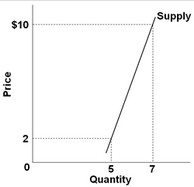When collective decision making is utilized to resolve economic questions regarding the allocation of resources, then:
a. everyone will receive an equal share of the output produced
b. the preferences of individuals are of no importance.
c. economic efficiency will be assured.
d. the role of markets will be replaced by political decision making.
d
You might also like to view...
Use the figure below to answer the following question.  Assume that price increases from $2 to $10. The price elasticity of supply (based on the midpoint formula) associated with this price change is about
Assume that price increases from $2 to $10. The price elasticity of supply (based on the midpoint formula) associated with this price change is about
A. 0.25 and supply is inelastic. B. 1 and supply is unit-elastic. C. 1.35 and supply is elastic. D. 4 and supply is elastic.
If the economy is in equilibrium and suddenly the level of planned investment increases by $2 billion, national income will increase by
a. $2 billion and stabilize at that level. b. less than $2 billion because of MPS. c. more than $2 billion because of MPC. d. less than $2 billion because of MPC.
The secondary market for bonds is a market for
a. bonds that is smaller than the primary market b. bonds that are not first-class c. previously issued bonds d. bonds that are not substitutes for bonds found in the primary market e. newly issued bonds
Cindy's Car Wash has average variable costs of $2 and average fixed costs of $3 when it produces 100 units of output (car washes). The firm's total cost is
a. $100. b. $200. c. $300. d. $500.